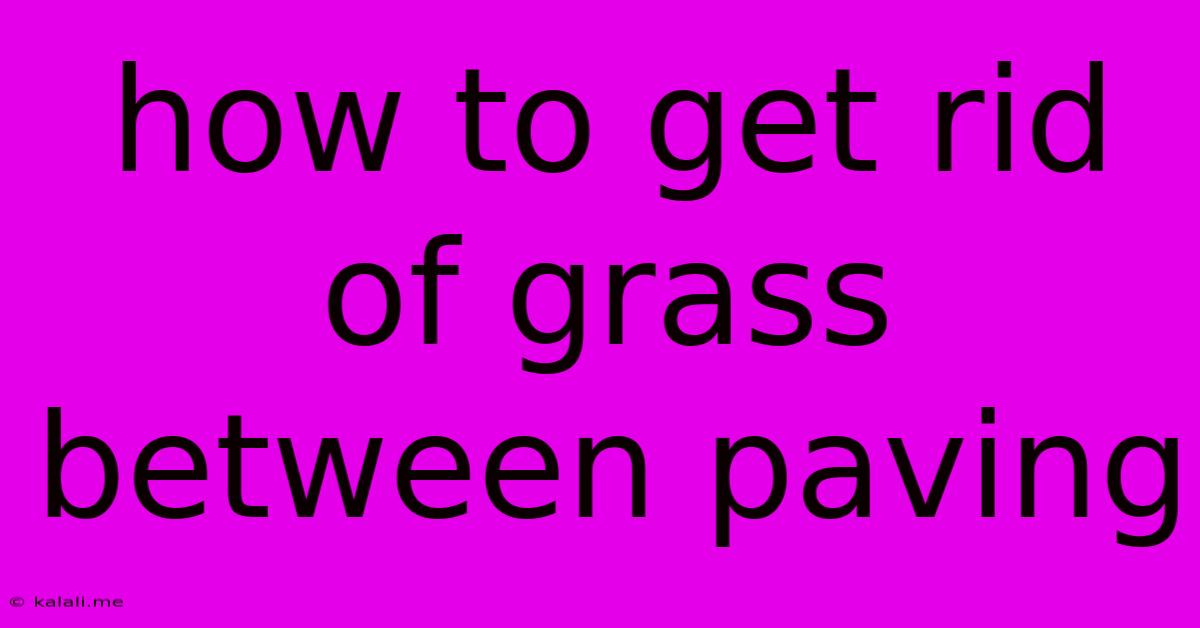How To Get Rid Of Grass Between Paving
Kalali
May 20, 2025 · 3 min read

Table of Contents
How to Get Rid of Grass Between Paving: A Complete Guide
Grass sprouting between paving stones is a common eyesore, making patios and driveways look untidy. This guide provides effective methods for removing existing grass and preventing future growth, ensuring your paved areas remain clean and attractive. Whether you have a small crack or a significant weed infestation, we've got you covered.
Why is grass growing between my paving stones? Grass seeds can be carried by wind, birds, or even on your shoes. Small gaps between paving stones provide ideal conditions for germination, especially in areas with fertile soil underneath. Understanding the source helps in choosing the right removal method and implementing preventative measures.
Methods for Removing Existing Grass
Several techniques can effectively eliminate unwanted grass between paving stones. Choose the method most suitable for your situation and the extent of the infestation:
1. Manual Removal:
- Hand weeding: For small areas with minimal grass, carefully pull out individual blades using tweezers or a small weeding fork. This method is time-consuming but avoids harsh chemicals. Be gentle to avoid damaging the paving.
- Scraping: Use a flathead screwdriver or a specialized weeding tool to scrape away surface-level grass. This works best for shallow-rooted grasses.
2. Chemical Weed Control:
- Selective herbicides: Apply a selective herbicide specifically designed for weeds in paved areas. These herbicides target grasses without harming surrounding plants. Always follow the manufacturer's instructions carefully and wear appropriate protective gear. Note that some herbicides can be harmful to pets and the environment.
- Total herbicides (use cautiously): Total herbicides kill all vegetation, including the grass. This method is effective but should be used sparingly as it can damage other plants and requires careful application to avoid unintended consequences.
3. Boiling Water:
- Pouring boiling water: Boiling water can kill grass effectively, particularly in smaller cracks. Pour the boiling water directly onto the grass. Be cautious when using this method to avoid burns or damage to the paving stones.
Preventing Future Grass Growth
Preventing grass from reappearing is just as crucial as removal. Here are some preventative strategies:
- Regular sweeping and cleaning: Regularly sweep or brush away loose debris and grass seeds to prevent them from taking root.
- Filling Gaps: Seal gaps and cracks between paving stones with appropriate filler such as polymeric sand or jointing compound. This prevents seeds from finding a foothold.
- Weed membrane: Before laying paving, consider using a weed-suppressing membrane underneath. This creates a barrier preventing weed growth from below.
- Regular maintenance: Keep your paving clean and clear of debris to discourage weed growth.
Choosing the Right Method
The best method depends on several factors:
- Extent of the infestation: For a few stray blades, manual removal might suffice. Larger infestations might require chemical control or more intensive methods.
- Type of paving: Some paving materials are more sensitive to chemicals than others.
- Environmental considerations: Consider the impact on the environment and any potential risks to pets or children when choosing chemical weed control.
By combining appropriate removal techniques with preventative measures, you can effectively eliminate grass between paving stones and maintain a clean, attractive outdoor space for years to come. Remember to always prioritize safety and follow manufacturer instructions when using any chemical products.
Latest Posts
Latest Posts
-
How To Address Many People In An Email
May 21, 2025
-
Words With The First Letter Silent
May 21, 2025
-
Do You Get Two Shots On The Black
May 21, 2025
-
Can I Bring Alcohol To Dubai
May 21, 2025
-
Can You Defrost Fish In Microwave
May 21, 2025
Related Post
Thank you for visiting our website which covers about How To Get Rid Of Grass Between Paving . We hope the information provided has been useful to you. Feel free to contact us if you have any questions or need further assistance. See you next time and don't miss to bookmark.